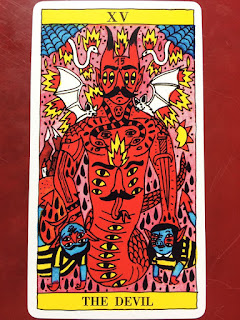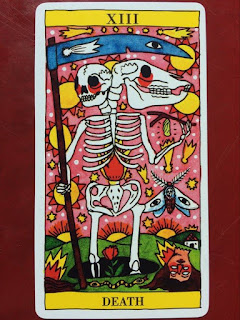Tarot del Fuego - The Devil - 15
 The TdF's Devil is a big red guy with a serpent's body, covered in tattoos and eyeballs. There are 21 in total, but only 17 of them appear to be a functional part of him. The other four are merely tattooed onto his chest. In the background there are a mountain, a house, and a Sun which are split in half. He has his big hands wrapped around the necks of two smaller blue serpent-people creatures. They are blue and wearing black and yellow-striped shirts. One is male, the other is female, one's head is upside down, the other's right side up. One's stripes are vertical, the other's horizontal. One has a human nose, the other a pig nose. They are apparently the same type of creature, but have a collection of differences that are mostly exactly the opposite of the corresponding trait in the other, similar to the sexual dimorphism (sex/gender-based physiological differences) found in humans. They appear to be his servants, and happy to be in that position. They look like weirder miniature versions of him.
The TdF's Devil is a big red guy with a serpent's body, covered in tattoos and eyeballs. There are 21 in total, but only 17 of them appear to be a functional part of him. The other four are merely tattooed onto his chest. In the background there are a mountain, a house, and a Sun which are split in half. He has his big hands wrapped around the necks of two smaller blue serpent-people creatures. They are blue and wearing black and yellow-striped shirts. One is male, the other is female, one's head is upside down, the other's right side up. One's stripes are vertical, the other's horizontal. One has a human nose, the other a pig nose. They are apparently the same type of creature, but have a collection of differences that are mostly exactly the opposite of the corresponding trait in the other, similar to the sexual dimorphism (sex/gender-based physiological differences) found in humans. They appear to be his servants, and happy to be in that position. They look like weirder miniature versions of him.The themes of splitting and the themes of opposites link the Devil to a kind of separation and fragmentation inherent within his archetype. Astrologically, the Devil is Capricorn. This constellation is associated with materialism, sexuality, hedonism, excess, and greed in its extreme manifestations. Although its excess can also be an excess in caution depending on context. It is a cardinal earth sign. The cardinal modality is active and initiating. Earth is stable, material, solid. Natives of this sign are famously hard-working and pragmatic. It is ruled by Saturn, which imparts a certain harshness and coldness to Capricorn. Saturn, then, brings us back to the themes of splitting and opposites. Saturn is the planet of division, chronology, time, separating, limiting, organizing, and hierarchy. The number of eyes present on the Devil also are representative of this theme. A holistic reckoning of reality would show all of the eyes as equal. But the Devil primarily recognizes difference between the 21 eyes, which represent the 21 archetypes beneath the Fool. From this perspective, some appear alive and active, some seem two-dimensional and inert.
The Hebrew letter associated with the Devil is Ayin, which means "eye" or "foundation." The eye, here, is symbolic of all of the senses. It denotes that the predominant mode of perceiving reality at this level of manifestation is through the means of the senses, which are inherently dualistic. The Devil is a foundation in that he is the first Principle of manifestation that is wholly grounded in the physical mode of existence. He is the point of transition between the mental/astral plane and the physical.
Like the central figure of the Temperance card, the devil has winged creatures attaching themselves to him, leaving the impression that he himself is a winged creature, albeit a composite one. Playing off of Temperance's angelic theme, the white bats sinking their teeth into the Devil's neck, wings outstretched, give off a correspondingly demonic vibe. The face on his abdomen, which seems to be a functional face, is pretty much the same as the face on his head, but its forked tongue is protruding, seeking out sense-experience. Like the face on the torso of the Hanged Man, the Devil's represents intuition, or a gut-level reaction. But not all gut instincts represent accurate intuitions. Sometimes they are simply fear-reactions that sabotage our best interests in one way or another.
The cobwebs in the upper corners of the card represent the web of Māyā, which is to say the sixth Trump of the Major Arcana, the Lovers. The number of the Devil, 15, reduces to six, informing us that there is a relationship between these two archetypes. The white serpents emerging from the cobwebs symbolize the Serpent Power, Kuṇḍalinī, of whom Māyā is simply one of many manifestations. In other words, Māyā is nothing other than Consciousness' own divine power of obscuration. The black raindrops in the background seem to represent the apparently dark power of the Devil. But the pink background itself stands in contrast, telling us that things, at their core, aren't what they seem; that the force which animates all the world is nothing other than Love.
The Devil's themes include vice, drugs, sex, bondage, selfishness, short-sightedness, attachments to things that are detrimental to us, stubbornness, and narcissism. But also diligence, hard work, and material success. It also carries the message that its bondage is only a matter of perspective.
The light of the body is the eye: if therefore thine eye be single, thy whole body shall be full of light. But if thine eye be evil, thy whole body shall be full of darkness. If therefore the light that is in thee be darkness, how great is that darkness! - Matthew 6:22, 23In the Tantrik system of the Principles of the manifestation of Consciousness, the 15th tattva is ahaṃkāra, the "I-maker." It is the faculty of the mind associated with egoity: the mind's tendency to assign identity to a mere fragment of the Self. This limited sense of self is usually confined to the body and mind. But probably only a portion of that even since it's extremely common for people to have little to no idea what is taking place within their own subconscious. People will go to extreme lengths to prop up this small self and make it look and feel important because they mistakenly think that that is all they are. Sometimes they'll even completely refuse to admit to anybody, including themselves, all kinds of things that they say and do in an effort to save face. While these are symptoms of certain clinical categories of personality disorder for sure, at their core, they are really just extreme landmarks along the continuum that is egoity. Acting from this level of awareness is binding. It generates karmic consequences, which basically amount to becoming even more mired down in egoity and the suffering that goes along with being stuck in that vantage point. A lot of New Age circles and time-honored yogic traditions alike have a very disparaging attitude toward the ego. But Tantra teaches us that the shift in perspective that is initiated by various yogic practices doesn't annihilate the ego. Rather, the sense of self simply expands until it eventually encompasses everything in the whole of manifestation and beyond. The Ribhu Gītā conveys this message in a way that I really love:
All that exists is this alone. Beloved, know yourself to be this alone. I am of the nature of nonduality without any second. This, I am. All is this. Beloved, know yourself to be this only and be happy. All this world, this life, this existence, this is your dance. Dance your dance. Be happy. Remain without attachment. Remain without desire and dance your dance. Remain in peace and dance your dance. Remain free. Remain whole. Remain perfect. Remain as this and dance your dance. This is all there is. Just this. Be one with this. All this is only your Self, not apart from you. Include all of this and dance your dance. Peace is your nature. Joy is your nature. Dance your dance.


Comments
Post a Comment